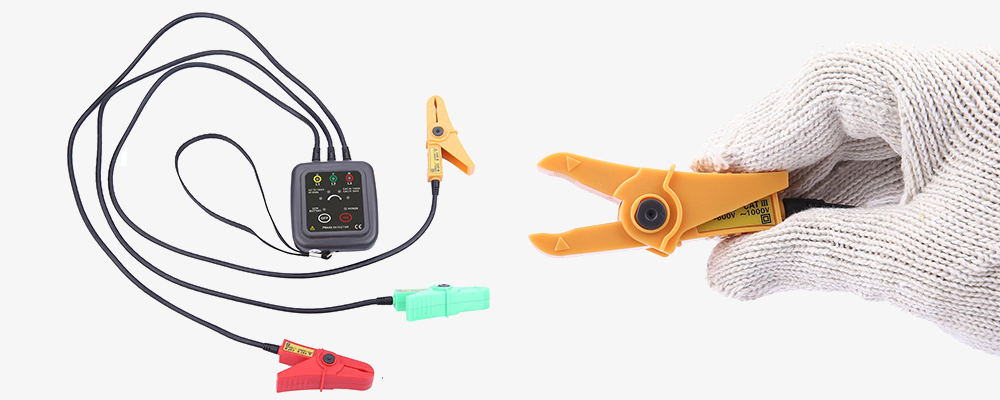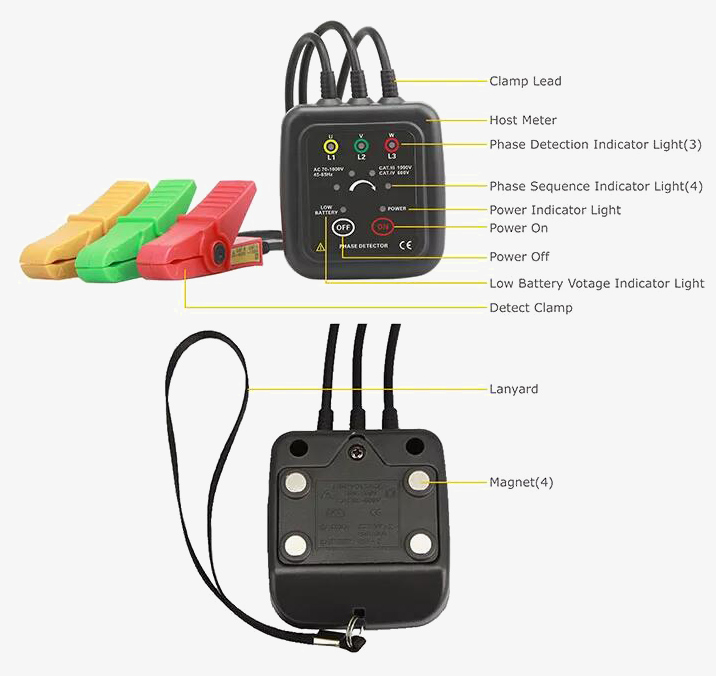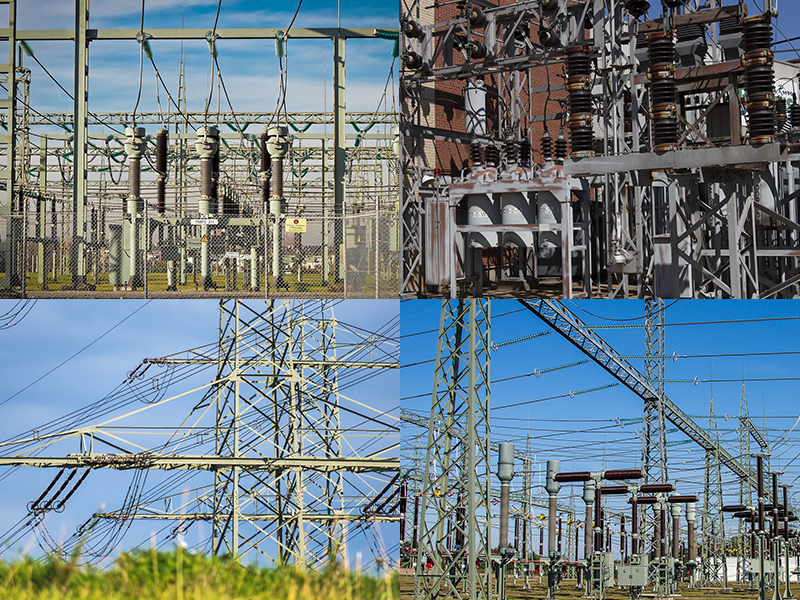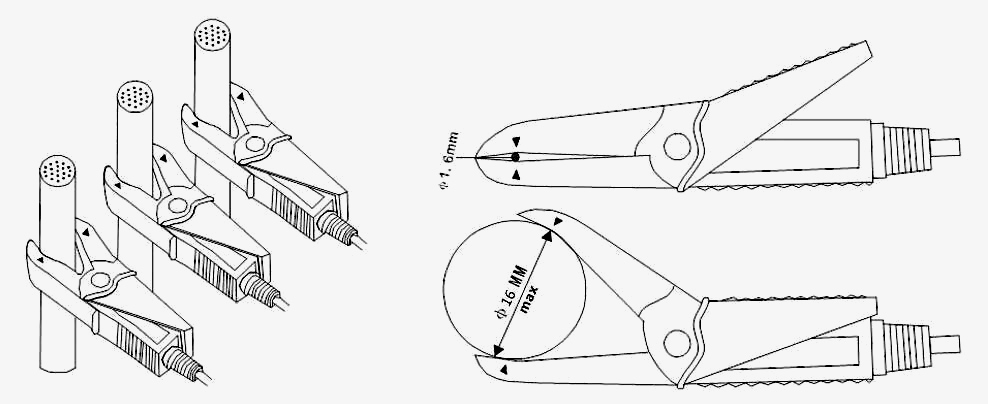High-quality phase tester for sale online. It comes with a voltage range 70V~1000V, 3xΦ1.6mm-Φ16mm. Non-contact phase rotation tester can detect the phase sequence by directly clamping three super-inductive high-insulation clamps to the insulation sheath of the three-phase live wire. live line inspection, open circuit search, breakpoint location, and line inspection functions are available, fast, safe and convenient. Phase testers are widely used in the power industry, electronic manufacturing, industrial control and other industries.

Features
- SISCO digital phase rotation tester adopts clamp type non-contact induction measurement, no need to peel off the cable skin, no need to contact the high voltage bare live wire.
- The phase sequence can be detected by directly clamping three ultra-induction and high insulation clamps on the insulation skin of the three-phase fire wire respectively. 3*Φ1.6mm-Φ16mm clamps are available.
- It is a non-contact phase rotation tester, safe and fast, and increases productivity.
- Dynamic acousto-optic displays the positive phase or anti-phase state of the three-phase power phase sequence.
- 4pcs magnets are installed on the bottom plate of the phase tester, which can be attached to the metal shell of the equipment in the test, convenient to operate.

Applications
SISCO phase rotation tester can perform phase verification and phase sequence verification of power lines and substations, with phase verification, phase sequence measurement, and electrical inspection functions. Strong anti-interference performance and is suitable for various electromagnetic field interference occasions. Phase detector is widely used in the power industry, electronic manufacturing, industrial control and other industries.

| Model | SISCO-PT-1000C |
| Available Clamp Wire Size | Φ1.6mm-Φ16mm |
| Weight | Host: about 210g; Total weight: about 350g(include accessories) |
| Power Supply | DC 3V AA alkaline batteries (LR6)×2PCS |
| Live Power Range | AC70-1000V, 45-65Hz (Sine Wave Continuous Input) |
| LED Display | [Positive phase sequence] The phase detector lamp lights up clockwise |
| [Anti-phase sequence ] The phase detector lamp lights up counterclockwise | |
| [Live power] L1, L2, L3 lamps light up in setting voltage range | |
| [Default phase] L1 or L2, or L3 lamp is not lighting | |
| [Open circuit] L1 or L2, or L3 lamp is not lighting | |
| Buzzer | [Positive phase sequence] the buzzer sounds intermittently |
| [Negative phase sequence] the buzzer sounds continuously | |
| Battery Check | The POWER indication lamp light up after boot up; the LOW BATTERY lamp light up when low battery |
| Magnet | 4pcs magnets are installed on the bottom plate of the instrument, which can be attached to the distribution box, load weight 800g |
| Auto Shutdown | 5 minutes after booting up, the meter automatically shutdown |
| Clamp Lead Length | 0.6m |
| Meter Dimension | 70mm×75mm×30mm |
| Max Measure Voltage | AC 1000V |
| Insulation Strength | 5.4kVrms |
| Maximum Rated Power | 300mVA |
| Accessories | Meter: 1PCS; Meter bag: 1PCS; Lanyard: 1PCS |
Clamp Details
Q1: How does a phase tester work?
A1: When the phase tester is working, the digital signal is sent to the receiving end through the wireless sending module, thereby reducing the interference and error, and greatly improving the working performance of the phase tester. When the phase detector is in use, first hang the transmitter on the conductor of the power grid under test, and then touch the receiving device to another grid conductor to be tested.
Q2: Functions of phase rotation indicators
A2: SISCO phase rotation indicators can perform phase sequence detection (positive phase, anti-phase, default phase), live line inspection, simple electrical inspection, fire line identification, default phase judgment, broken line location search, DC line breakpoint detection, and line maintenance.
Q3: Why do you need a contactless phase rotation meter?
A3: If AC power supplies with different phases or phase sequences are paralleled or closed, a large current will be generated, which will cause damage to the generator or electrical equipment, so a phase detector is required for measurement.
Phase verification refers to the use of a tester or other means to check whether the phases and phase sequences of two power sources or loops are the same in the electrical operation of the power system, which means the measurement of the phase difference in the actual operation. Newly built, rebuilt and expanded substations and transmission lines, as well as after the line is overhauled and before power is sent to users, must conduct three-phase circuit phase verification tests. Therefore, a phase tester is required.
Tips: What is a low-voltage phase rotation tester?
The low-voltage phase rotation tester refers to the low-voltage nuclear phase instrument, the general phase voltage is 1V-1000V. This low-voltage phase detector (SKU: SISCO-PRT-710) is a non-contact tester, does not need to be touched, and can judge the phase sequence in three seconds. It is one of the most popular phase detectors.
Thank you for buying industrial test and measurement equipment on SISCO.com, all products sold by SISCO and the partner cover a 12 months warranty, effective from the date of receiving the products.
What is covered?
SISCO is responsible for providing free spare parts, and free technical support to assist the customer to repair the defective products until the problem is solved.
What is not covered?
- Product purchased from anyone other than a SISCO store or a SISCO authorized reseller.
- Expendable parts.
- Routine cleaning or normal cosmetic and mechanical wear.
- Damage from misuse, abuse or neglect.
- Damage from use of parts other than SISCO approved.
- Damage from use outside the product’s usage or storage parameters.
- Damage from use of parts not sold by SISCO.
- Damage from modification or incorporation into other products.
- Damage from repair or replacement of warranted parts by a service provider other than a SISCO authorized service provider.
- Damage caused by the application environment not meeting the product usage requirements and the failure to perform preventive maintenance.


